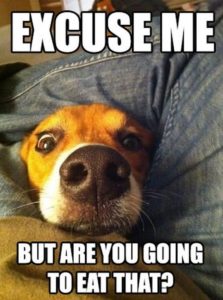The Science Behind Treats

by Lauren Rubin
Fun science fact: behavior that gets reinforced is more likely to happen again! This is the primary concept behind how we train here at Training Spot. It’s also why the clicker works – your dog understands that when they hear a click, it means whatever behavior they were just doing is going to result in something amazing.
In training, that something amazing is usually treats! This is because most animals are food motivated, humans included: it’s necessary for our survival, so we are driven to eat. Dogs are natural scavengers, meaning they are good at finding food and spend a large part of their lives looking for it. Just ask anyone who has a counter surfer or garbage thieving dog!
The fact that reinforced behaviors are likely to happen more often actually explains how dogs learn to counter surf or raid trash. Jumping on the counter resulted in a tasty treat, so your dog tries again. With reinforcement, the behavior can quickly become a habit, even after just one try!
While this is frustrating for dealing with a counter surfer, it’s great news for training our dogs. Food is generally easy to bring to class and use in exercises. It’s also easy to take on the road for training sessions in your home, neighborhood or local outdoor café!
That being said – food is not the only reinforcer out there! At home (where you have more space and less distractions) you may want to try mixing things up. Does your dog love tennis balls? Ask for a behavior they know, then click and bounce the ball for them! Dog enjoy greeting people? Ask for a nice behavior, then allow your dog to go say hi! Did your dog walk nicely on leash past a squirrel? Click and go chase that squirrel!
Just remember – a reinforcer is something that your dog finds motivating! If you have a dog who prefers his space, then you may weaken a behavior by using the chance to greet as a reinforcer. If your dog feels mediocre about fetch, then bouncing a ball is not going to impress her!
Dogs who are undermotivated by the choice of reinforcer will learn more slowly or struggle around distractions. Not all dogs are motivated by the same treats – just because my dog loves cheese doesn’t mean your dog will find it good. Some dogs will work for their kibble, even in high distraction environments! Most dogs, however, will need a higher reinforce to learn in touch situations. My dog works for cheese at home and in class, but when we go for walks in high traffic areas, she does much better with deli meats or Cheese Whiz.
Along those lines, it’s also worth noting that dogs who actively dislike something may not learn at all, or may learn not to do a behavior, if you use it in place of a reinforcer. My dog dislikes being pet on the head, so patting her on the head would actively punish a behavior! Even though I would love for her to be motivated by praise and petting, I avoid using them as reinforcers because my dog finds one unmotivating and the other downright unpleasant in the learning environment.
To sum up: find what motivates your dog, and use it to your advantage! And don’t worry – you won’t need to use treats forever. Once your dog has learned a behavior, you can wean off the treats. But that’s a blog post for another time!